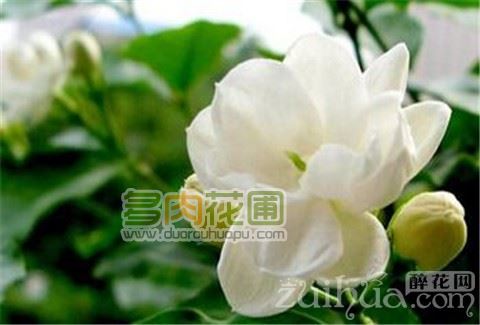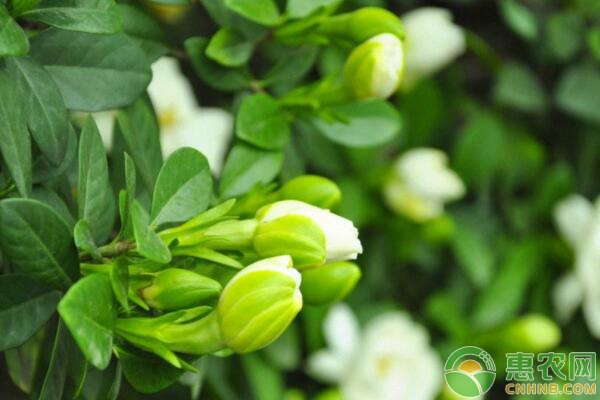What are the main diseases and insect pests of jasmine? How to prevent and cure?
The main diseases of jasmine are white silk disease, purple striped feather disease, branch blight, insect pests are shell insects, stem borer, red spider, flower bud borer, jasmine leaf borer and so on. The prevention and control methods are as follows:
1. White silk disease
The main results are as follows: (1) the disease is easy to occur under the condition of high temperature and humidity, so the garden with good ventilation and light transmission and good drainage should be selected, and attention should be paid to drainage in rainy season to reduce humidity.
(2) bacterial soil should not be used in potted plants. The basin soil can be heated and sterilized with more than 50% warm water for 24 hours, and then used after drying.
(3) remove the diseased plant and burn it centrally, spread lime around the pit of the diseased plant, disinfect the soil and then replant the new plant.
(4) at the initial stage of the disease, 50% carbendazim 500-fold solution was used to irrigate the soil around the stem, or 500-fold thiophanate solution was used, or 0.3% stone-sulfur mixture was used to irrigate and then sprinkled with lime powder. Take out the seedling when you get sick, wash it in clean water, disinfect it with 1000 times liter mercury water and replant it.
two。 Branch blight
(1) cut off the diseased branches and burn them in time.
(2) spray 800 times carbendazim or topirazine, spray 3% 5% stone sulfur mixture during dormancy, spray 50% carbendazim wettable powder 500 times or 75% chlorothalonil wettable powder 500 times during growth period.
3. Purple feather disease (root rot)
Spray 1000 times of carbendazim wettable powder, or fill the root neck with 1000 times of mercury water, or 100 times of Sailisan lime water, or 1000 times potassium permanganate solution. The serious plants were dug up and burned, and the planting pits were disinfected and replanted.
4. Crustaceans
(1) remove the damaged branches and leaves and burn them.
(2) spraying 800-1000-fold liquid of imidophos, marathon and fenitrothion, or spraying 10-15-fold turpentine mixture in non-flowering period.
5. Red spider
During the occurrence period, 40% dicofol was sprayed 1000 times, or 40% omethoate 1000 times, or 50% tricyclic tin wettable powder 2000 times, or 73% carotene emulsion 1500 times 2000 times. 0.2%-0.3% stone-sulfur mixture is used in summer, and a variety of drugs can be used alternately.
6. Flower bud borer and leaf borer (mosaic worms and leaf rollers)
Remove the damaged buds, branches, leaves and pupae in time. 1000 times solution of 50% fenitrothion was sprayed during the occurrence of larvae.
What are the main diseases and insect pests of jasmine? How to prevent and cure?
What are the main diseases and insect pests of jasmine? How to prevent and cure?
The main diseases of jasmine are white silk disease, purple striped feather disease, branch blight, insect pests are shell insects, stem borer, red spider, flower bud borer, jasmine leaf borer and so on. The prevention and control methods are as follows:
White silk disease
The main results are as follows: (1) the disease is easy to occur under the condition of high temperature and humidity, so the garden with good ventilation and light transmission and good drainage should be selected, and attention should be paid to drainage in rainy season to reduce humidity.
(2) bacterial soil should not be used in potted plants. The basin soil can be heated and disinfected with warm water above 50 degrees Celsius for 24 hours, and then used after drying.
(3) remove the diseased plant and burn it centrally, spread lime around the pit of the diseased plant, disinfect the soil and then replant the new plant.
(4) at the initial stage of the disease, 50% carbendazim 500-fold solution was used to irrigate the soil around the stem, or 500-fold thiophanate solution was used, or 0.3 °stone-sulfur mixture was used to irrigate and then sprinkle with lime powder. Take out the seedling when you get sick, wash it in clean water, disinfect it with 1000 times liter mercury water and replant it.
2) Branch blight
(1) cut off the diseased branches and burn them in time.
(2) spray 800 times carbendazim or thiophanate, spray 3 °- 5 °stone sulfur mixture during dormancy, spray 50% carbendazim wettable powder 500 times or 75% chlorothalonil wettable powder 500 times during growth period.
3) Purple stripe (root rot)
Spray 1000 times of carbendazim wettable powder, or fill the root and neck with 1000 times of mercury water, or 100 times of Sailisan lime water, or 1000 times potassium manganate solution. The serious plants were dug up and burned, and the planting pits were disinfected and replanted.
4) crustaceans
(1) remove the damaged branches and leaves and burn them.
(2) spraying imidophos in non-flowering period. Marathon, fenitrothion 800-1000 times liquid, or spray 10-15 times turpentine mixture.
5) Red Spider
Spray 40% dicofol 1000 times, or 40% omethoate 1000 times, or 50% tricyclic tin wettable powder
2000-3000 times liquid, or 73% propargite emulsion 1500-2000 times
Liquid. 0.2 °- 0.3 °stone-sulfur mixture can also be used alternately in summer.
6) Bud borer and leaf borer (flower heart worm and leaf curl)
Remove the damaged buds, branches, leaves and pupae in time. 1000 times solution of 50% fenitrothion was sprayed during the occurrence of larvae.
What are the requirements for the prevention and control of diseases and insect pests of jasmine
Jasmine is a kind of flower that many flower lovers like to breed, and many people raise it at home. This plant is divided into fragrance and can also repel mosquitoes. Flowering is also very beautiful, but many people do not know how to cultivate jasmine, which is embarrassing. Let's take a look at the requirements of cultivating jasmine and the key points of jasmine pest control.

1 temperature
Jasmine flowers like high temperature, usually begin to sprout at about 20 ℃, conceive buds at more than 25 ℃, and form buds at about 28 ℃ to 33 ℃. The optimum temperature for growth is 22 ℃ to 35 ℃, the temperature is too high, the plant is in a semi-dormant state, the flowering is less and uneven, the plant grows slowly at low temperature, and it is not tolerant to low temperature, and some branches will freeze to death when it is below 5 ℃ for a long time.
2 moisture
Jasmine flowers like the soil moist, can be once a week, about 250 milliliters. But afraid of stagnant water in the basin, if the basin soil is in a wet state for a long time, the root system will rot due to lack of oxygen in the basin soil, and the leaves will gradually turn yellow and fall off, or even the whole plant will die.
3 Sunshine
Jasmine flowers like the sunny environment, sufficient light, thick green leaves, stout branches, many buds, good coloring and strong aroma. Otherwise, the plants will grow excessively, the leaves are light green, the branches are slender, the internodes are long and tender, the buds are few, the flowers are small and fragrant.
4 fertilization
Jasmine likes fertilizer, but fertilization should be carried out according to its growth law. In winter and summer, when the temperature is above 35 ℃, the growth period should keep enough reasonable fertilizer, pay attention to the uniform proportion of nitrogen, phosphorus and potassium fertilizer, and give priority to phosphorus and potassium fertilizer during the budding period, in order to promote the formation of more flower buds, and avoid excessive fertilization or the application of immature organic fertilizer, so as not to cause root burns and yellowing leaves. During the whole growing period, the retting alum fertilizer water or ferrous sulfate solution was sprayed every 1 to 2 weeks.
(5) Disease and pest control
Jasmine flowers are vulnerable to pests such as red spiders, so ventilation should be strengthened, and attention should be paid to observation at ordinary times. once insect harm is found, trichloroacarol should be used to control it in time.
Jasmine leaf spot is a common disease of jasmine. The disease usually occurs from May to June, and the peak period is from July to August. In the early stage of the disease, light brown spots appeared on the infected leaves, and then spread around, the disease part became thin and brown transparent, round or irregular, the disease part became thin, translucent, brown, and the edge of the disease spot was obvious. Finally, there are black particles on the disease spot. The diseased leaves should be removed in time and destroyed centrally. During the onset period, 65% Dysen zinc wettable powder 600 times to 800 times liquid, or 75% chlorothalonil wettable powder 800 times liquid, etc. were sprayed 3 to 4 times in a row, with an interval of 10 to 14 days.
- Prev

Cultivation method of jasmine in pot
The main results are as follows: (1) according to the characteristics of good permeability and humid environment of jasmine root system, pot jasmine should be planted in plain mud basin, glaze basin, porcelain basin and so on. There are generally three specifications of plain burning mud basin suitable for planting jasmine: caliber 25cm, 15cm high, and caliber 30cm.
- Next

How to cultivate and maintain gardenia?
Gardenia flowerpot planting should be carried out around April, the soil should choose fertile, loose and well-drained slightly acidic soil, it is best to use rotten leaf soil plus mountain mud, and add a small amount of cake fertilizer and bone powder as base fertilizer. It is better to transplant seedlings with soil balls, pour water after planting, place them in shade for about 10 days, move to sunny places, and transfer to normal maintenance.
Related
- Fuxing push coffee new agricultural production and marketing class: lack of small-scale processing plants
- Jujube rice field leisure farm deep ploughing Yilan for five years to create a space for organic food and play
- Nongyu Farm-A trial of organic papaya for brave women with advanced technology
- Four points for attention in the prevention and control of diseases and insect pests of edible fungi
- How to add nutrient solution to Edible Fungi
- Is there any good way to control edible fungus mites?
- Open Inoculation Technology of Edible Fungi
- Is there any clever way to use fertilizer for edible fungus in winter?
- What agents are used to kill the pathogens of edible fungi in the mushroom shed?
- Rapid drying of Edible Fungi

